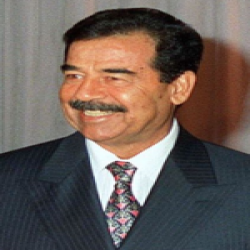
Saddam Hussein
Iraqi Politician and President
| Date of Birth | : | 28 April, 1937 |
| Date of Death | : | 30 December, 2006 (Aged 69) |
| Place of Birth | : | Al-Awja, Saladin Governorate, Iraq |
| Profession | : | Politician |
| Nationality | : | Iraq |
Saddam Hussein (সাদ্দাম হোসেন) was an Iraqi politician and revolutionary who was the fifth president of Iraq, from 16 July 1979 until 9 April 2003. He also served as prime minister of Iraq, first from 16 July 1979 until 23 March 1991, and later from 29 May 1994 to 9 April 2003.
Biography
Saddam Hussein led Iraq from 1979 to 2003. During his rule, he projected an image of himself as Iraq's most influential leader and a courageous modernizer, but at the same time, his repressive regime killed thousands of people.
- Saddam Hussein Abd al-Majid al-Tikriti Abd al-Magid al-Tikriti; 28 April 1937 – 30 December 2006) was President of Iraq from 16 July 1979 until 9 April 2003.
- A leading member of the revolutionary Arab Socialist Ba'ath Party, and later, the Baghdad-based Ba'ath Party and its regional organization the Iraqi Ba'ath Party—which espoused Ba'athism, a mix of Arab nationalism and socialism—Saddam played a key role in the 1968 coup (later referred to as the 17 July Revolution) that brought the party to power in Iraq. As vice president under the ailing General Ahmed Hassan al-Bakr, and at a time when many groups were considered capable of overthrowing the government, Saddam created security forces through which he tightly controlled conflicts between the government and the armed forces.
- In the early 1970s, Saddam nationalized oil and foreign banks leaving the system eventually insolvent mostly due to the Iran–Iraq War, the Gulf War, and UN sanctions.
- Through the 1970s, Saddam cemented his authority over the apparatus of government as oil money helped Iraq's economy to grow at a rapid pace.
- Positions of power in the country were mostly filled with Sunni Arabs, a minority that made up only a fifth of the population.Saddam formally rose to power in 1979, although he had already been the de facto head of Iraq for several years.
- He suppressed several movements, particularly Shi'a and Kurdish movements which sought to overthrow the government or gain independence, respectively, and maintained power during the Iran–Iraq War and the Gulf War.
- Whereas some in the Arab world lauded Saddam for opposing the United States and attacking Israel, he was widely condemned for the brutality of his dictatorship.
- The total number of Iraqis killed by the security services of Saddam's government in various purges and genocides is conservatively estimated to be 250,000.
- Saddam's invasions of Iran and Kuwait also resulted in hundreds of thousands of deaths. In 2003, a coalition led by the United States invaded Iraq to depose Saddam, in which U.S.
- President George W.
- Bush and British Prime Minister Tony Blair erroneously accused him of possessing weapons of mass destruction and having ties to al-Qaeda.
- Saddam's Ba'ath party was disbanded and the country's first ever set of democratic elections were held.
- Following his capture on 13 December 2003, the trial of Saddam took place under the Iraqi Interim Government.
- On 5 November 2006, Saddam was convicted by an Iraqi court of crimes against humanity related to the 1982 killing of 148 Iraqi Shi'a, and sentenced to death by hanging.
- He was executed on 30 December 2006.
Quotes
Total 6 Quotes
Don't be attracted to easy paths because the paths that make your feet bleed are the only way to get ahead in life. Saddam Hussein
Women make up one half of society. Our society will remain backward and in chains unless its women are liberated, enlightened and educated. - Saddam Hussein
The west need someone to tell the man who walks around with the biggest stick in the world, that that stick can`t bring down God`s house.” - Saddam Hussein
Politics is when you say you are going to do one thing while intending to do another. Then you do neither what you said nor what you intended. - Saddam Hussein
Whoever tries to climb over our fence, we will try to climb over his house. - Saddam Hussein
I just didn't believe Bush. - Saddam Hussein